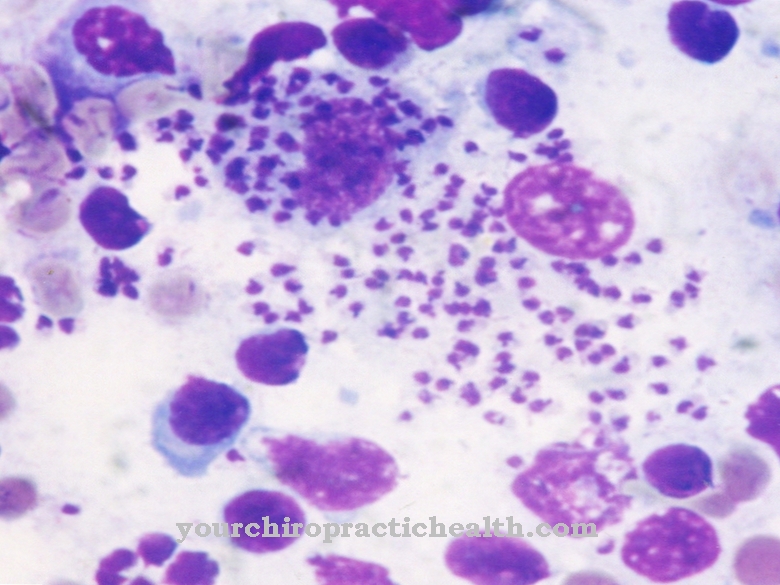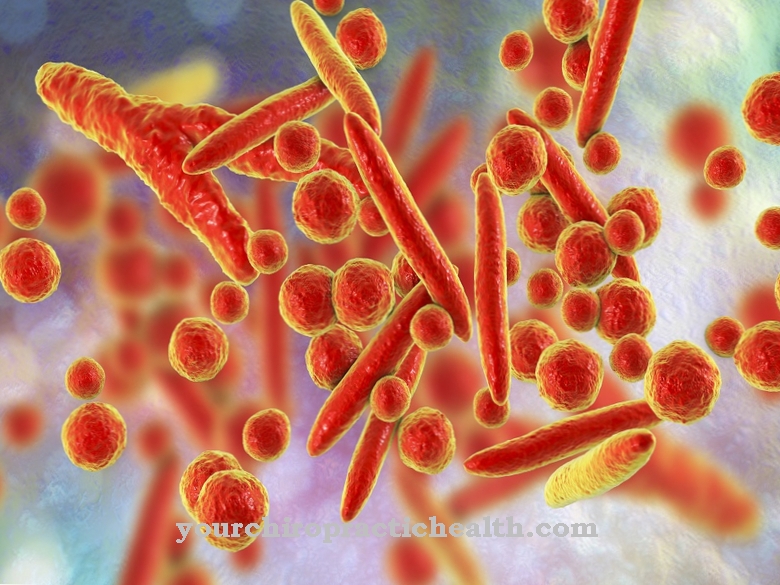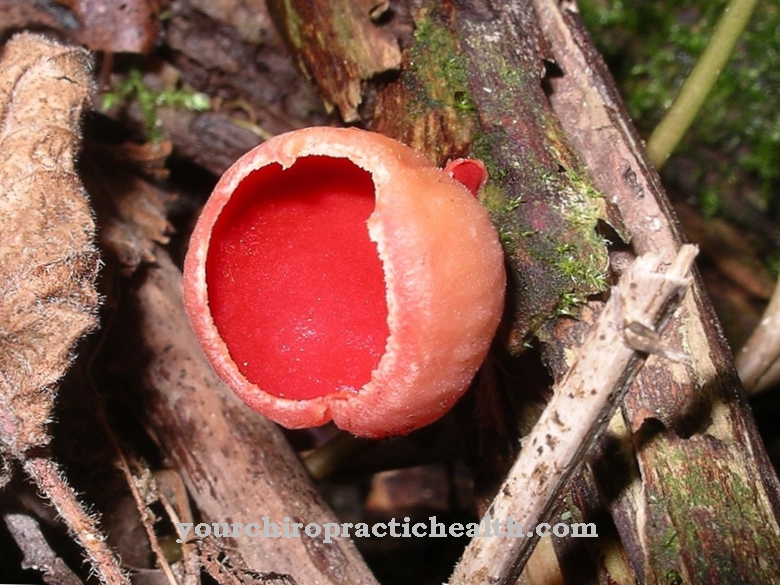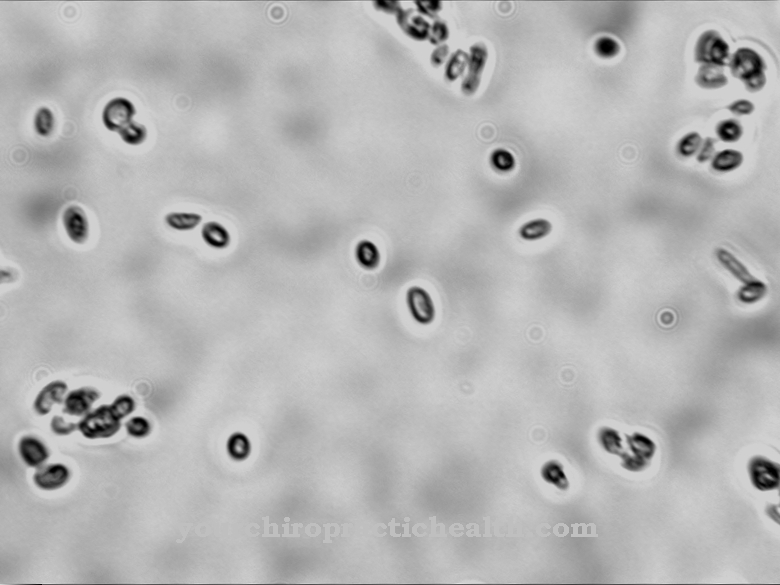Under the term Streptococcus viridans several groups of streptococcal bacteria are combined. They can cause pathological processes such as tooth decay and inflammation.
What is Streptococcus Viridans?
The name Streptococcus viridans is actually misleading. It is not a single species, but different types of streptococci, which in turn consist of several subgroups. The term therefore makes more sense Viridans streptococci classified. What is meant are spherical gram-positive bacteria that come from the genus of streptococci (Streptococcus).
The name Viridans streptococci can be traced back to historical reasons and is used in microbiology. Streptococcus viridans are green streptococci. The Latin term 'viridans' means in German 'greening' or 'greening'. Since the bacteria settle in the mouth and throat region, they are also known as oral streptococci.
Although some species of Streptococcus viridans can cause disease, most subspecies are not considered to be pathogenic.
Occurrence, Distribution & Properties
The Viridans streptococci, while comprising different species, share some common characteristics. In this way they form coke-shaped cells, which are arranged in chains in numerous representatives of this species. They do not form endospores. Gram staining has a positive outcome. Greening or alpha hemolysis of the streptococcal colonies that have grown occurs on a blood-containing nutrient medium.
Another typical characteristic of Streptococcus viridans is that it stops growing at temperatures above 10 degrees Celsius. At temperatures of 45 degrees, however, most streptococci are still able to multiply.
For medicine it is important to be able to differentiate Streptococcus viridans from other Streptococcus species, such as Streptococcus pneumoniae. This species is also one of the alpha-hemolytic streptococci. Identification is possible using an Optochin test. In addition, the members of Streptococcus pneumoniae can be recognized as diplococci. Streptococcus viridans also lacks polysaccharide capsules and the antigens of Lancefield groups A, B, C and D.
Viridans streptococci are usually found in the mouth and in the ear, nose and throat region. They are also found in the gastrointestinal tract and vagina.
At the beginning of the 20th century, science still assumed that Streptococcus viridans was a single specific species that could be distinguished from Streptococcus haemolyticus. Streptococci that had alpha hemolysis were given the name 'greening streptococci'. However, numerous differences between the Viridans streptococci have become known over the years, so that further subdivisions were made from 1937 onwards. In this way, the Streptococcus viridans group received more and more new species, including y-hemolytic streptococci, of which no hemolysis was performed. For this reason, medicine ultimately divided the Viridans streptococci into several groups.
The classification of Streptococcus viridans includes four groups. These are the Milleri group, also known as the Anginosus group, the Oralis group, the Mutans group and the Salvarius group. Members of the Milleri group are Streptococcus intermedius, Streptococcus constellatus and Streptococcus anginosus. The Oralis group includes Streptococcus mitis, Streptococcus sanguinis and Streptococcus mitior. The Mutans group consists of Streptococcus mutans, Streptococcus cricetus and Streptococcus subrinis, while the Salvarius group consists of Streptococcus salvarius, Streptococcus bovins and Streptococcus thermophilus.
The Bovis group does not count among the oral streptococci. Alpha hemolysis is possible in this group, but they also have Lancefield group D antigens.
You can find your medication here
➔ Medication for toothacheIllnesses & ailments
Some types of Streptococcus viridans are capable of causing ailments and diseases. For this reason, doctors also refer to them as opportunistic or pathogenic pathogens. So call u. a. Streptococcus mutans and Streptococcus sobrinus for the production of extracellular polysaccharides caries. Bacteria grow on the polysaccharide coating, which in turn form substances that affect human tooth enamel.
Bacteremia is also possible if the mouth is injured by chewing or during dental treatment. This is understood to mean the washing of bacteria into the human bloodstream. As a rule, the bacteria in the blood are eliminated immediately, but if this does not happen, there is a risk of life-threatening sepsis (blood poisoning).
A particularly worrying disease that can be caused by members of Streptococcus viridans is bacterial endocarditis. 50 to 70 percent of this inflammation is caused by Viridans streptococci, which applies to the subacute form of endocarditis lenta of bacterial endocarditis. The sick people, who are primarily patients with heart valve damage, suffer from endocarditis from sweating, feelings of weakness, palpitations (tachycardia) and fever. In some cases, other organs can also be affected by the disease. Basically, endocarditis lenta takes a gradual course. There is a risk of the formation of watch glass nails, drumstick fingers and anemia.
To diagnose endocarditis lenta, among other things, the creation of a bacterial culture can take place, which is one of the microbiological procedures. For safety reasons, three samples are taken independently of one another. Echocardiography is another diagnostic option.
Antibiotics are used to treat endocarditis. Streptococcus viridans is particularly sensitive to penicillin. As a rule, empirical therapy takes place first until the pathogen is specifically detected.
Members of the Viridans streptococcal group, such as Streptococcus milleri, sometimes cause purulent abscesses. Occasionally they can also cause meningitis. Streptococcus viridans is also classified as a concern for people who take immunosuppressive drugs.

























.jpg)


